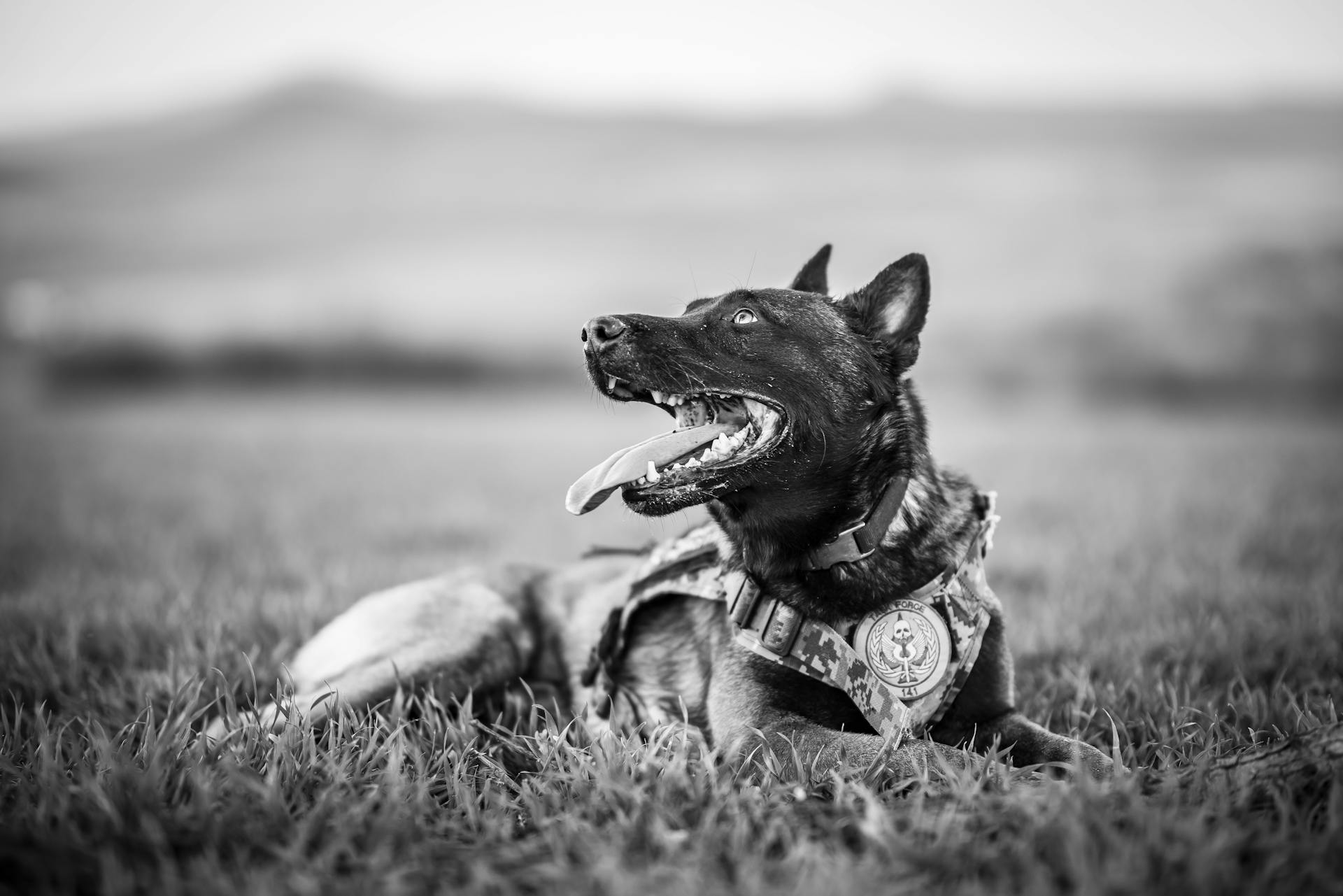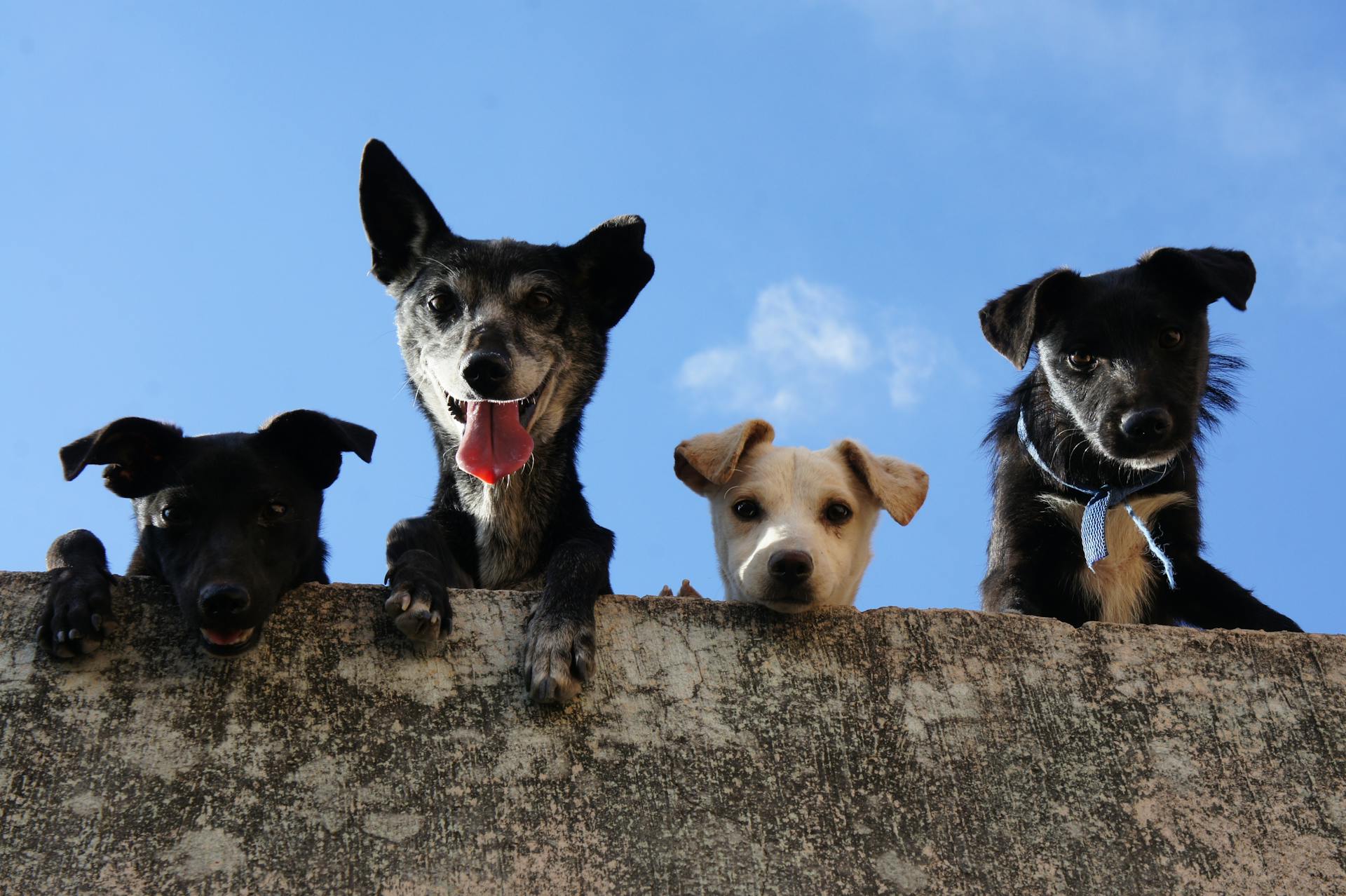
Police dogs are an essential part of law enforcement teams, trained to detect and track suspects, find missing people, and locate narcotics and explosives. They're a valuable asset to police departments worldwide.
Police dogs typically start their training at a young age, around 1-2 years old. Their trainers work with them to develop their skills and build a strong bond.
Their training involves learning to follow commands, navigate obstacles, and detect specific scents. It can take up to 2 years to complete their training.
These highly skilled dogs are deployed in various situations, including search and rescue operations, narcotics detection, and suspect apprehension.
Recommended read: How Dog Years Work
Police Dog Breeds
Police dogs come in a variety of breeds, each with its own unique abilities and strengths. German Shepherds are probably the most preferred police dog breed due to their high energy levels, versatility, and ease of training.
Their intelligence and ability to work for long periods without getting tired make them ideal for police work. They're also relatively easy to train, which is a big plus.
Some police dogs are single-purpose, meaning they have one specific task they perform, while others are dual-purpose, trained to do a variety of tasks. Labrador Retrievers, for example, are often used for drug and explosive detection and search and rescue due to their friendly nature and keen sense of smell.
Belgian Malinois are another common police dog breed, known for their speed and agility. They're smaller and lighter than German Shepherds, but just as intelligent and trainable.
Here are some popular police dog breeds:
- German Shepherds
- Belgian Malinois
- Bloodhounds
- Dutch Shepherds
- Labrador Retrievers
Each breed has its own unique strengths and weaknesses, and the right breed for the job depends on the specific task and requirements.
See what others are reading: Police Dogs Breeds
Apprehension and Detection
Police dogs are incredibly versatile and play a vital role in law enforcement. They're trained to apprehend suspects in situations where their human partners are at risk.
Herding breeds like Belgian Malinois, German Shepherd Dogs, and Dutch Shepherds are often used for apprehension due to their physical strength and intelligence. These breeds have been bred for centuries to herd livestock, and their skills translate well to restraining a dangerous person.
Apprehension dogs must be stable and able to distinguish between a threat and a harmless situation. They're trained to respond solely to their handler's commands, not to act on their own judgment.
Dogs are also used for detection, taking advantage of their incredible sense of smell. With 225 million scent receptors in their noses, compared to a human's 5 million, they can detect a wide range of substances, including drugs, explosives, and accelerants.
Police dogs are often deployed in high-risk areas like airports, border entries, and large events, where they can quickly sniff out potential threats.
Apprehending Suspects
Apprehending suspects is a critical task that police dogs are trained for. They can bite suspects in a non-lethal way to neutralize them until officers release the dog.
Herding breeds like the Belgian Malinois, German Shepherd Dogs, and Dutch Shepherds are often used for suspect apprehension due to their physical strength and intelligence.
These breeds were originally bred to herd livestock, and their natural abilities make them well-suited for restraining a person. They must be stable dogs to handle high-pressure situations.
Police dogs will go head-first into a dangerous situation to protect their human partners from an armed suspect.
Detection
Dogs have 225 million scent receptors in their noses, compared to a human's 5 million. This incredible sense of smell makes them perfect for detecting various substances.
Dogs can detect drugs, explosives, accelerants, and other crime scene evidence. Their powerful noses allow them to sniff out these substances with ease.
You'll often see dogs at airports and border entries, sniffing for bombs, drugs, and contraband food items. This is because their sense of smell is up to 60 times stronger than a human's.
Many military dogs can detect landmines, protecting their handlers and personnel from danger. This is just one example of how their incredible sense of smell can be used for good.
You might like: How Do Service Dogs Detect Seizures
Search and Rescue
In search and rescue operations, police dogs play a vital role in locating missing people. Their incredible sense of smell can detect human scents even in the most challenging environments.
Police dogs can be trained to find both living victims and human remains of the deceased. This is crucial in cases where many people are missing, such as after a major explosion or natural disaster.
In situations where one person or a small group are lost in a large area, like hikers in a forest, police dogs can be invaluable in finding them.
Global's Approach
Global's Approach to Police K9 Training is centered around one key aspect: handler protection. This means that the primary goal of any dog trained by Global is to defend its owner.
A properly trained K9 will attack in the event of an attack on its handler, regardless of being commanded to do so. This reflects the dog's loyalty and demonstrates the strong bond between a working dog and its handler.
The bond between a working dog and its handler is absolutely crucial, and Global's training program emphasizes this loyalty above all else. It's what separates good working dogs from great working dogs.
Global's Police K9 Training program teaches working dogs to guard criminal suspects while being detained, questioned, and searched by their handlers. This is the most common use of police K9s, but the training can be tailored to specific needs.
German Shepherds and Belgian Malinois are often the most successful candidates for police K9 training, and they respond well to the program. These breeds are fiercely loyal and adjust well to the handler-protection mentality.
You might like: Statistics on Pit Bulls
The Process
Police dogs require constant rehearsal and hours of ongoing training to excel in their roles. This is especially true for police K9 dogs, which demand even more training than regular dogs.
Police K9 dogs don't just complete their training program and then stop learning. In fact, the most important factor to their success is the maintenance work that occurs long after training has been completed.
The Process
Global Training Academy welcomes hundreds of patrol dogs and their handlers to their facility in Somerset, Texas every year.
Training a police dog requires constant rehearsal and ongoing training, which is even more extensive than training a regular dog.
The most important factor to success is often the maintenance work that occurs long after training has been completed.
Police K9 dog handlers return to refresh and update their handler training, which is a common practice.
It's a significant undertaking to keep a police dog in working shape, but the right information and skills can make all the difference.
What You'll Do

As a canine handler, you'll be part of a team that helps protect Australia and its citizens. You'll work with highly trained dogs and handlers across the country.
You'll maintain and deploy general purpose police canines, helping with tasks such as looking for offenders and missing people. You and your dog will also respond to critical incidents and support Tactical Response operations.
Detection handlers, on the other hand, will work with dogs trained to detect specific items like cash, drugs, explosives, firearms, and technology. These dogs are incredibly skilled, sniffing between 5 to 10 times a second and having a smell processing capacity 40 times stronger than humans.
You'll have the opportunity to work across teams and alongside people in various roles within the AFP. You and your dog will live together, with general purpose dogs living with their handlers and detection dogs living in centralised kennels.
Here are some of the tasks you'll perform as a canine handler:
- Looking for offenders and missing people
- Responding to critical incidents
- Supporting Tactical Response operations
- Detecting cash, drugs, explosives, firearms, and technology
Frequently Asked Questions
Where do most police dogs go after their work shifts are over?
Most police dogs return home with their handlers after work, where they spend time with their families and enjoy activities like camping and hiking
Sources
Featured Images: pexels.com


